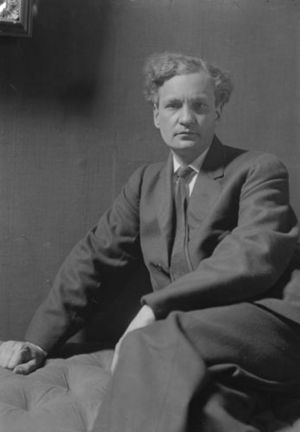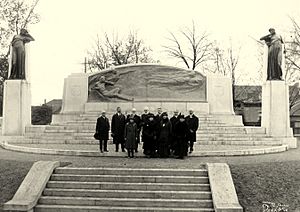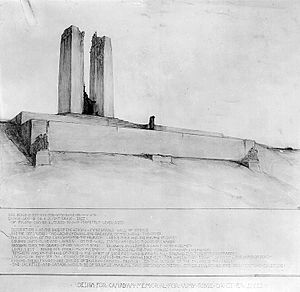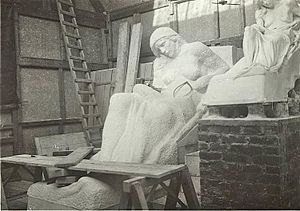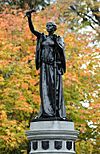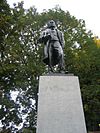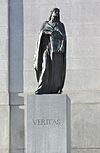Walter Seymour Allward facts for kids
Walter Seymour Allward (18 November 1874 – 24 April 1955) was a Canadian sculptor. He is most famous for designing the Canadian National Vimy Memorial. Allward's sculptures often show strong, classic figures. They remind people of important ideas like memory, sacrifice, and hope. Many people have praised his unique way of arranging sculptures and his amazing skill.
One of Allward's early important works was the Bell Memorial in 1917. This monument made him well-known. It led to him creating the Canadian National Vimy Memorial in France, which is his most famous work. Some of his sculptures are also kept at the National Gallery of Canada in Ottawa. Allward also drew about one hundred pictures about war when World War II started.
People have called Allward "probably Canada's most important monumental sculptor" in the early 1900s. After he passed away in 1955, his name was not as well-known. But in 2001, he became a character in a popular book called The Stone Carvers by Jane Urquhart.
Contents
Walter Allward's Early Life
Walter Allward was born in Toronto, Canada. His father was John A. Allward and his mother was Emma Pittman from Newfoundland. Walter went to public schools in Toronto. When he was 14, he started working with his father, who was a carpenter.
Allward first learned about building design at an architecture firm called Gibson and Simpson. Then, he worked at the Don Valley Brick Works. There, he was good at making clay models for building decorations. He also took art classes at the New Technical School. All this training helped him become a famous sculptor.
Allward's Amazing Sculptures
First Sculptures
Allward's first big project was a figure called Peace. It was for the Memorial of the Battles in the North-West (1895) in Queen's Park, Toronto. He won this competition when he was only 19 years old. He had not had much formal training as a sculptor.
Other early works included a life-sized sculpture of Dr Oronhyatekha. This was for the opening of the Temple Building in Toronto (1899). He also created the Old Soldier (1903). This sculpture remembers the War of 1812 in Toronto's Portland Square. In 1903, he became a member of the Royal Canadian Academy. By 1918, he was a full member. He then received requests to create sculptures of famous people. These included Lord Tennyson, Sir Charles Tupper, and Sir Wilfrid Laurier. In Queen's Park, you can also see his statues of General John Graves Simcoe (1903) and Sir Oliver Mowat (1905).
Grand Monuments
Allward was especially good at creating large, heroic monuments. These included the design for the Boer War Memorial Fountain in Windsor, Ontario (1906). He also designed the South African War Memorial in Toronto (1910). The Baldwin-Lafontaine Monument on Parliament Hill in Ottawa (1914) was another of his works.
His Bell Memorial (1917) in Brantford, Ontario remembers Alexander Graham Bell's invention of the telephone. Allward also designed a memorial for King Edward VII. But World War I started, so it was never finished. Two bronze figures, Veritas (Truth) and Iustitia (Justice), were made for this memorial. They were found in their crates in 1969, buried under a parking lot. In 1970, they were placed outside the Supreme Court of Canada in Ottawa. Allward also designed many war memorials in towns across Canada. These include the Stratford Memorial (1922) and the Peterborough Memorial (1929).
The Bell Memorial
In 1906, people in Brantford and Brant County wanted to remember the invention of the telephone. Alexander Graham Bell invented it in July 1874 at his parents' home in Brantford, Ontario. Allward's design was chosen from 10 different models. The memorial was supposed to be finished by 1912. However, Allward did not complete it until five years later. The Governor General of Canada, Victor Cavendish, 9th Duke of Devonshire, officially opened the memorial on 24 October 1917.
Allward designed the monument to show how the telephone helps people connect over long distances. Steps lead up to the main part. Here, a figure called Inspiration is above a man representing Man, the inventor. This figure points to other floating figures: Knowledge, Joy, and Sorrow. At each end of the memorial, two female figures stand on stone bases. They represent Humanity, one sending a message and the other receiving it.
The Bell Telephone Memorial is considered one of Allward's best early works. It made him very famous. The memorial is still an important part of Brantford's history. It helps the city call itself "The Telephone City."
The Vimy Memorial
Allward's most important project was the monument for Canadians killed in the First World War. He worked on this project from 1921 until it was opened on 26 July 1936. King Edward VIII unveiled it. About 100,000 people were there, including over 50,000 Canadian and French veterans and their families. The Vimy Memorial became a National Historic Site of Canada in 1996. After a $30 million repair, the monument was opened again on 9 April 2007.
Allward made 150 design sketches before his final plan was chosen by the Canadian government. The Canadian Battlefields Memorials Commission chose Vimy Ridge for the memorial. This was because it was high above the ground below, which fit Allward's design. France gave the land (Hill 145) to Canada forever. In June 1922, Allward opened a studio in London, England. He spent almost two years looking for the perfect stone for the memorial. He found it in the ruins of Diocletian's Palace. This stone, called Seget limestone, came from an old Roman quarry in Croatia. The stone had to be dug out, shipped by boat to France, and then taken to Vimy Ridge by truck and train.
Allward used a new building method. He used a concrete frame and then attached the limestone to it. The memorial's base and two tall towers use almost 6,000 tonnes of Seget limestone. This sits on about 15,000 tonnes of concrete. The 20 symbolic figures were carved right where they stand now. Professional carvers used life-sized plaster models made by Allward. They used a tool called a pantograph to make the figures twice as big. All this work happened inside temporary studios built around each figure, even those at the top of the towers.
The first figure finished was Canada Bereft. It stands at the top of the front wall of the Vimy Memorial. It looks like traditional pictures of the Virgin Mary in sadness. Canada Bereft is now one of the most famous sculptures in Canadian art. The figures on top of the towers represent good qualities like charity, faith, honor, hope, justice, knowledge, peace, and truth. Truth and Knowledge have angel wings. This usually means victory, but victory is not part of this monument about sadness.
Most of the original plaster figures are kept at the Canadian War Museum in Ottawa.
The last step was to carve the names of 11,285 Canadians on the memorial's walls. These soldiers were killed in France and are buried in unknown places. Building the huge concrete and steel base took a long time. Getting 6,000 tons of stone from Croatia also caused delays. Roads had to be built, and the site had to be cleared of mines and graves. In 1930, Prime Minister R. B. Bennett wanted the project finished by 1932. But it took four more years. The total cost was about $1.5 million.
Allward's Works
| Work | Date | Location | Notes | Image |
|---|---|---|---|---|
| Peace (North-West Rebellion Memorial) | 1895 | Queen's Park, Toronto | ||
| Sculpture of Oronhyatekha | 1899 | Temple Building, Toronto | Commissioned by Oronhyatekha and the Independent Order of Foresters to mark the opening of the Temple Building. Moved to Forester House at 789 Don Mills Road in 1970. | |
| Old Soldier | 1903 | Victoria Memorial Square, Toronto | Remembers the War of 1812 | |
| Sculpture of John Graves Simcoe | 1903 | Queen's Park, Toronto | First Lieutenant-Governor of Upper Canada | |
| Sculpture of Sir Oliver Mowat | 1905 | Queen's Park, Toronto | Third Premier of Ontario | |
| Boer War Memorial Fountain | 1906 | Windsor, Ontario | ||
| Sculpture of John Sandfield Macdonald | 1909 | Queen's Park, Toronto | First Premier of Ontario | |
| South African War Memorial | 1910 | University Avenue, Toronto | ||
| Sculpture of Robert Baldwin and Louis-Hippolyte Lafontaine | 1914 | Parliament Hill, Ottawa | ||
| Bell Telephone Memorial | 1917 | Bell Memorial Gardens, Brantford, Ontario | Remembers the invention of the telephone by Alexander Graham Bell in 1874 at his parents' home in Brantford, Ontario | |
| Veritas (Truth) | 1920 | Supreme Court of Canada, Ottawa | Made for the unfinished King Edward VII memorial. Found buried in 1969 and placed in front of the Supreme Court in 1970. | |
| Justitia (Justice) | 1920 | Supreme Court of Canada, Ottawa | See Veritas, above | |
| Stratford Cenotaph | 1922 | Stratford, Ontario | ||
| Citizens' War Memorial | 1929 | Peterborough, Ontario | ||
| Brant County War Memorial | 1933 | Brantford, Ontario | ||
| Canadian National Vimy Memorial | 1936 | Vimy Ridge (near Vimy, Pas-de-Calais), France | ||
| Bust of William Lyon Mackenzie | 1940 | Queen's Park, Toronto |
Awards and Recognition
In 1944, Walter Allward was given the title of Companion of the Order of St Michael and St George. This was for his great work in Canadian Art. He was also a member of the Royal Canadian Academy of Arts.
On 30 June 1938, Prime Minister William Lyon Mackenzie King spoke about Allward in the House of Commons of Canada. He said that the House wanted to thank Mr. Walter S. Allward. As the designer of the Vimy Memorial, he created a beautiful and special work of art. The Prime Minister added that the Vimy Memorial would always show Canada's efforts in the war. It would also honor those who fought to protect freedom.
Allward is recognized as an Historic Person by the Canadian government.
Allward's Legacy
Walter Allward's art continues to be seen in many important monuments in Canada and other countries. He became a member of the Royal Canadian Academy of Arts in 1903. His bronze artwork from 1920, The Storm, is now part of the National Gallery of Canada. He is also a character in Jane Urquhart's book The Stone Carvers.
See also
 In Spanish: Walter Allward para niños
In Spanish: Walter Allward para niños


